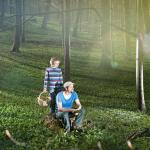Frankenstein and the Illuminati, the first state university and the Bavarian Purity Law all originated in Ingolstadt! The city on the Danube is easily underestimated, yet it fascinates all with its beautiful old town, creative scene and plenty of greenery. Text: Markus Stein, Photos: Tobias Gerber
Discover Ingolstadt
“We like it there, guys, we'll stay there!”, that’s what people might have said in ancient times when they discovered the place where the little river “Schutter” flows into the Danube. Crossing over the Danube, then a jumble of different river branches, was probably easy – and well-suited for trade routes. Thus, a settlement and a hub for the Europe-wide transfer of goods and culture emerged as early as the Bronze Age.
Sensational evidence of this is a necklace made of Baltic amber. It was excavated near Ingolstadt and can now be admired in the city museum. The jewellery consisting of 2,787 beads stems from the era in which the Egyptians fought with the Hittites and the mask of Agamemnon was hammered into sheet gold in Mycenae. This proves that the original inhabitants of Ingolstadt were already well-connected with other areas of the globe!
“Ingolds Stätte” Makes Its Presence Felt
Much later, a reference is made to a “Stätte des Ingold” at the mouth of the Schutter, which was mentioned in a document of Charlemagne. It was promoted to a town around 1250. During the short existence of the Duchy of Bavaria-Ingolstadt from 1392 to 1447, Ingolstadt was even the capital of the royal residence, and, in 1516, it was the scene of the proclamation of the Bavarian Beer Purity Law, which was revolutionary in terms of beer brewing technology. And, from 1472 to 1800, the city enlightened all of Old Bavaria as the seat of the first Bavarian university! Today, Ingolstadt is the second largest city in Upper Bavaria with 140,000 inhabitants.
Schanzer and Schwedenschimmel
Cannon barrels and the clang of weapons are as much a part of Ingolstadt’s history as beer brewed according to the city’s strict purity laws. The city’s location was always considered strategically important, and it was developed into a fortress from the 16th century. Even today, its inhabitants call it “Auf der Schanz” and themselves “Schanzer” – a local reference to the city history as a fortress location.
Famously, the cabinet piece from the Thirty Years’ War, when Gustav II. Adolf cut his teeth at the fortress: during the siege in 1632, the men succeeding in shooting the horse out from under the Swede. The poor stallion went on to be stuffed and today enjoys an unexciting existence as an exhibit in the city museum. Anyway.
There was no match for Napoleon. The infamous man from Corsica, after surrendering without a fight, left the fortress without further ado. Which offered the opportunity for a new building. Bricklaying began on the “Royal Bavarian Mainland Fortress” in 1828, including according to plans by star architect Leo von Klenze.
It became the most expensive project under Ludwig I in terms of security, after all, the state fortress was supposed to be a place of refuge for the royal family and the crown treasure in the event of an emergency. “Munich nourishes me, Ingolstadt protects me,” the monarch is famous for saying. This case never happened, thank goodness.
Green, So Green!
The system of walls and towers, gates and bastions still encircles the city like a protective belt. It forms an open-air museum of fortress architecture, and is also the reason why Ingolstadt is considered one of the greenest major cities in Bavaria!
Situated in front of the bastions is the “Glacis”, a firing range that previously sported no greenery and that was not allowed to be built on, and which is now a “green lung” with trees and meadows. It is only a few steps from the old town into the green.
Two parks are particularly appealing: the “Künettegraben” with two beer gardens and the “Klenzepark” with its wide lawns – ideal for walking, cycling, jogging or just lying in the meadow. In summer, open-air concerts are held there with thousands of visitors.
Herbs and fruit may be harvested free of charge for personal use
Herbs, Orchard Meadows, Riparian Forests
“The Klenzepark is Ingolstadt’s green parlour,” says Bernward Wilhelmi, head of the garden department. “Our herb garden at ‘Neues Schloss’ is something special,” says Wilhelmi, “anyone can pick oregano, thyme, sage and other herbs there. You can also harvest apples, plums, pears or cherries for free for your own use in the parks’ orchards, which can be found on the city website!”
If you fancy more greenery, feel free to roam – preferably by bike – through the western woodlands along the Danube, such as the “Gerolfing Eichenwald”, an important cultural landscape, and the species-rich riparian forests.
Victor Frankenstein and the Illuminati
From luminous green to Ingolstadt’s famous night life. “Finally, I caught sight of the city’s tall white spires.” This is how Victor Frankenstein describes his arrival in Ingolstadt in the novel “Frankenstein” or “The Modern Prometheus” by Mary Shelley, published in 1818. He had travelled from Geneva by coach. He would go on to spend eleven of twenty-four chapters in the city, unravelling the mysteries of life.
Ingolstadt’s university was highly respected and tailor-made for the inquisitive Frankenstein. In addition, the scholar Adam Weishaupt founded the secret society of the “Illuminati” in 1776 in house no. 23 of today’s Theresienstraße.
Monster Alert!
Weishaupt wanted to “make the rule of men over men superfluous through enlightenment and moral improvement”. Something that did not please the authorities. Thus, the Illuminati soon became the victim of fierce defamation and conspiracy theories, and were later even accused of having instigated the French Revolution, before finally being banned in 1784.
This fitted well with the novel’s mysterious and eerie setting. If Weishaupt planned for a new human being with a new moral compass, it was in Frankenstein that a new creature was “actually” created, from corpse parts, with the well-known, monster-like consequences.
Bigger than Notre-Dame in Paris!
The old town of Ingolstadt is easy to explore on foot. You start at “Schliffelmarkt”, for example, where citizens used to meet for a chat over a glass of wine, and walk along the wide “Theresienstraße”, past the stunning houses adorned with Renaissance gables. And then you find yourself in front of the “Liebfrauenmünster”.
The church building seems too big for this city. Due to lack of money, it was not completed – and yet it remains impressive. The roof truss made of seven thousand tree trunks is three times as big than that of Notre-Dame in Paris! Remarkable features in the interior include the splendid folding altarpiece and the (inconspicuous) tomb slab of Johannes Eck, a chief ideologue of the Counter-Reformation and pastor at the church. The portrait of this pugnacious theologian on a wall relief is strikingly reminiscent of his opponent Luther ...
Just a few steps from the cathedral and you have already reached the “Kreuztor”. The medieval double-gated construction made of red brick is the town’s landmark, and it pleased King Ludwig II so much that he had it depicted in the “Sängersaal” hall at his magnificant castle in Neuschwanstein.
Coffee Break at the “Anatomie”
If you turn south, you reach the next highlight: the “Alte Anatomie” medical museum. The magnificent, late Baroque building was erected for the Faculty of Medicine, and was the first building constructed for anatomy in Germany (from 1735). Today, it is the seat of the Museum of Medical History. The newly conceived permanent exhibition is very informative and beautifully designed. Visitors can view paintings, sculptures and historical equipment, from the amputation saw (around 1700) to the tooth root lifter (around 1800) – and are sure to be left feeling ever more grateful for all that modern medicine has to offer!
Here, people are very happy about the blessings of modern medicine
Tip: If you really don’t feel like getting a breath of museum air, just visit the museum café (you can also do this without a ticket) and enjoy the botanical garden with its fountain while sipping a cappuccino on the terrace.
Just a stone’s throw further and you pass through the “Taschentorturm”, once a prison and executioner’s residence, and enjoy a good view of the medieval city wall with its towers. Towards the city centre through “Taschenturmstraße” ... and you are at the “Hohe Schule”, once the seat of the first Bavarian state university.
Craft Beer and Poetry Slam
The alleys around the cathedral are a popular nightlife area. You will find shops and trendy places like “Griesmüllers Altstadtbrauerei” with its craft beers or the funky craft beer bar “Zwølf by Yankee+Kraut”, the art and culture pub “das Mo” with its beer garden, or why not relax at the “Café Himmelblau”. Or the “Diagonal” stage in the community centre.
“...from conservative to urban, you can find simply everything here”
Once there, you occasionally meet the young children’s book author (“The Little Things”) and poetry slammer, Kevin Reichelt. “Today, I don’t perform myself, but I organise the poetry slams. The ‘Brüllaffen-Slam’ has been taking place every six to eight weeks at the Diagonal for years,” says the twenty-something.
Kevin, who grew up in Ingolstadt, is a fan of the old town, appreciates the “many places with charm” and likes its inhabitants. “It’s quite a special vibe, you can find everything from conservative to urban here.”
Other tips from the scene connoisseur: the “Altstadttheater”, especially the experimental “Kleine Haus”, the art pub “Neue Welt” with a varied programme from blues to cabaret, and the “KAP94” with its “Better than TV” programmes, a mix of literature, music and comedy. And by no means should you miss the “Donaustrand” in summer!
The open-air stage with beach feeling, which opens up to the water like an amphitheatre, is located on the right bank near the “Donausteg”. The residents of Ingolstadt enjoy themselves there between May and October at concerts or poetry slams, or they simply chill out and enjoy the sunsets.
12 Highlights in Ingolstadt
Which locations, museums and other sights are worth a visit? We reveal what you should see and experience in Ingolstadt

